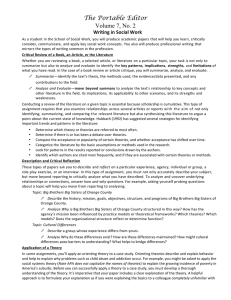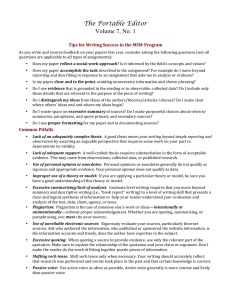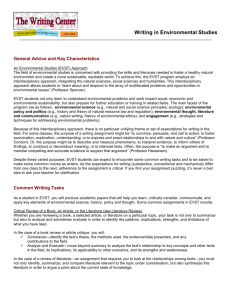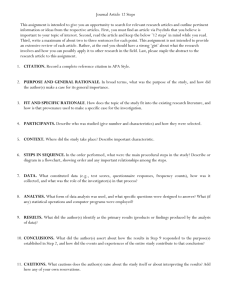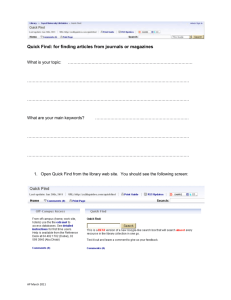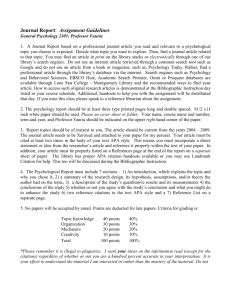Writing in Social Work
advertisement
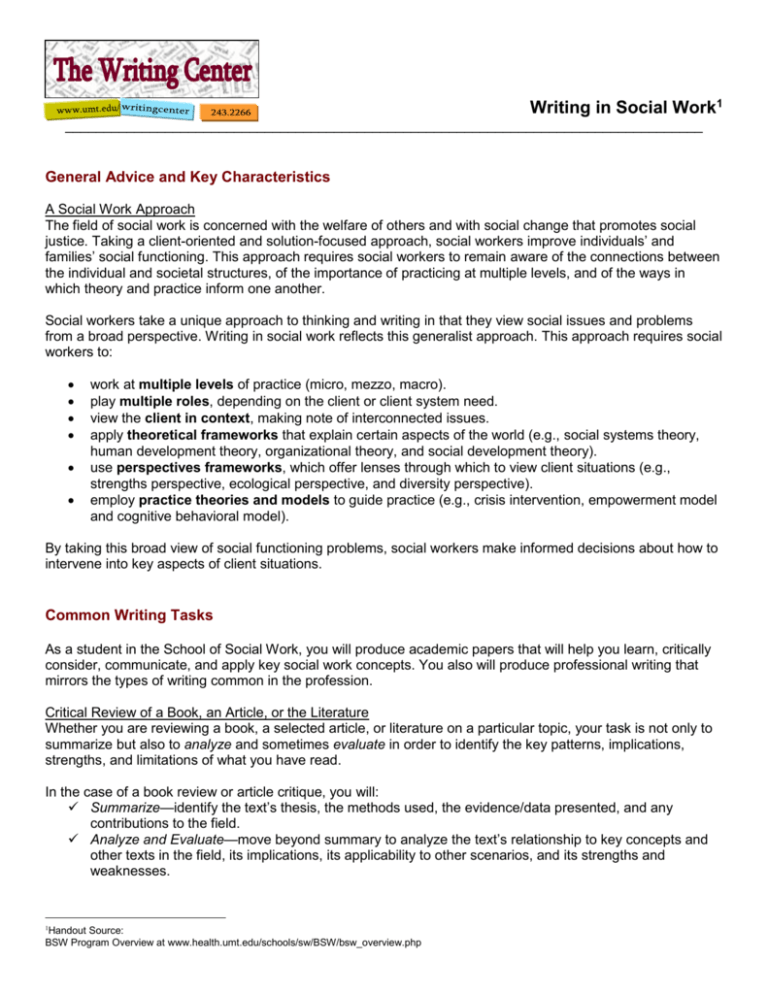
Writing in Social Work1 ___________________________________________________________________________________ General Advice and Key Characteristics A Social Work Approach The field of social work is concerned with the welfare of others and with social change that promotes social justice. Taking a client-oriented and solution-focused approach, social workers improve individuals’ and families’ social functioning. This approach requires social workers to remain aware of the connections between the individual and societal structures, of the importance of practicing at multiple levels, and of the ways in which theory and practice inform one another. Social workers take a unique approach to thinking and writing in that they view social issues and problems from a broad perspective. Writing in social work reflects this generalist approach. This approach requires social workers to: work at multiple levels of practice (micro, mezzo, macro). play multiple roles, depending on the client or client system need. view the client in context, making note of interconnected issues. apply theoretical frameworks that explain certain aspects of the world (e.g., social systems theory, human development theory, organizational theory, and social development theory). use perspectives frameworks, which offer lenses through which to view client situations (e.g., strengths perspective, ecological perspective, and diversity perspective). employ practice theories and models to guide practice (e.g., crisis intervention, empowerment model and cognitive behavioral model). By taking this broad view of social functioning problems, social workers make informed decisions about how to intervene into key aspects of client situations. Common Writing Tasks As a student in the School of Social Work, you will produce academic papers that will help you learn, critically consider, communicate, and apply key social work concepts. You also will produce professional writing that mirrors the types of writing common in the profession. Critical Review of a Book, an Article, or the Literature Whether you are reviewing a book, a selected article, or literature on a particular topic, your task is not only to summarize but also to analyze and sometimes evaluate in order to identify the key patterns, implications, strengths, and limitations of what you have read. In the case of a book review or article critique, you will: Summarize—identify the text’s thesis, the methods used, the evidence/data presented, and any contributions to the field. Analyze and Evaluate—move beyond summary to analyze the text’s relationship to key concepts and other texts in the field, its implications, its applicability to other scenarios, and its strengths and weaknesses. 1 Handout Source: BSW Program Overview at www.health.umt.edu/schools/sw/BSW/bsw_overview.php In the case of a review of literature—an assignment that requires you to look at the relationships among texts—you must not only identify, summarize, and compare literature relevant to the topic under consideration, but also synthesize this literature in order to argue a point about the current state of knowledge. Description and Critical Reflection These types of papers ask you to describe and reflect upon a particular agency, a particular individual or group, a role play exercise, or an in-class interview. In this type of assignment, you must not only accurately describe your subject, but also move beyond reporting to critically analyze what you have described. To analyze and uncover underlying reasons, answer how and why questions. For example: Topic: Big Brothers Big Sisters of Missoula Describe Big Brothers Big Sisters of Missoula’s history, mission, goals and objectives, structure, and programs. Analyze why Big Brothers Big Sisters of Missoula is structured in this way and how certain practice models and theoretical frameworks influence the agency’s mission. Topic: Cultural Differences Describe a group whose experiences differ from yours. Analyze why these differences exist and how they might pose barriers to understanding. Application of a Theory Some social work assignments ask you to apply an orienting theory to a particular case. Orienting theories help to explain why things such as child abuse and addiction happen. For example, you may be asked to apply the social systems theory to explain poverty in a certain community. Before you successfully can apply a theory to a case study, it is imperative that you have a good understanding of the theory. Once you have a good understanding of the theory, you can apply the theory to a specific case study that focuses on a particular unit of analysis (i.e. a social group, agency, or individual). When applying a theory to a particular example, you must analyze the example as it compares to the theory. That is, what does the theory help you to understand about the example? What does the theory fail to help you understand (where is it not a good fit)? Social Work Research Paper Research papers in social work require that you identify a problem or question worth investigating and perform research that will help you to solve the problem or answer the question. Therefore, a key step in writing a social work research paper is identifying an important question or problem, a step that requires lots of reading and note taking. Invest time in formulating a strong research question or problem that you can then work to answer or solve by collecting data or by reading relevant literature. For example: Identify a focused topic—depression among the elderly Formulate a question—what are the unique barriers to addressing depression among the elderly? Social Policy Analysis Social policy analysis papers critically evaluate the effectiveness of social policy. By understanding the outcomes of these policies and making recommendations, social workers inform future decision making. These papers generally include the following sections: 1. The Issue: Clearly define the social problem the policy addresses. 2. Background: Describe the historical development and original intent of the policy and how it attempts to address the social problem in question. 3. Analysis: Analyze the social policy, focusing on its strengths and limitations in addressing the problem. 4. Recommendation: Propose social policy alternatives that might better address the problem. 5. Conclusion Professional Writing Assignments Writing is an important part of a social worker’s professional life. Often, a client’s welfare is dependent on the social worker’s ability to write in a professional manner. Three common types of professional writing in social work are case notes, assessments, and treatment plans. Each type grows out of good listening skills; accurate case notes, a clear assessment, and an effective treatment plan rely on accurate and objective details recorded during client interviews. This means you must record facts as opposed to opinions. When you do offer a professional opinion, support it with relevant facts. Case Notes—These are objective descriptions or observations of a situation. Case notes are accurate, clear, and concise, and should represent what you’ve observed, not your personal opinions. Assessments—These are descriptive compilations of data gathered to present a cohesive view of an individual or family. Assessments represent what you think professionally, not personally, and are descriptive, not diagnostic. Treatment Plans—These outline an intervention that includes specific goals and objectives. Goals are usually broad statements while objectives are measureable actions to be taken. Keep in mind that these documents become part of a client’s record and that others will read and make decisions based what you’ve written. Common Moves for Writers in Social Work Understand the Task and Revise Before you begin thinking, researching, and writing in response to an assignment, know what is being asked of you. Are you being asked to analyze, describe, discuss, evaluate, explain, reflect, or summarize? Each of these verbs directs you to do something different, and sometimes you may be asked to do more than one thing in a single assignment. Also, do not confuse your writing process with your final product. The magic in good writing is careful revision. Make use of Writing Center tutors and other expert readers as you revise and refine your thinking and writing. Provide Relevant Details When describing a client, group, or agency, provide only those details that are relevant to the purpose of the piece of writing. Avoid extraneous details that will not help the reader understand your subject, and avoid inserting opinions and judgments. Provide details that show rather than tell. For example, instead of claiming that a client’s house is “dirty,” provide the concrete details that led you to this conclusion. Move beyond Description Some assignments will ask you not only to describe an agency, policy, situation, or text but also to analyze your subject. This means you must pay attention to underlying explanations (perhaps using orienting theories), potential implications, and practice theories and models that may have influenced decisions. Critical analysis seeks to understand the why and how behind an agency, policy, situation, or text. Use Appropriate Evidence Whether you are making a critical argument about a text or set of texts or a data-oriented argument, you must substantiate your argument with appropriate evidence. In social work, always take care to distinguish between your opinion and evidence that is grounded in what a text actually says or in what the data actually tell you. Be rigorous in making this distinction. Use subject librarians throughout the research process Librarians at the Mansfield Library can help you identify and evaluate source materials, narrow your focus, and refine your ideas. Effective research strategies are a key part of a successful writing process. Document sources accurately and ethically Writers in social work use the American Psychological Association (APA) format for citation. Developed by professionals in the field, this documentation style allows writers to document consistently those aspects of source materials that most matter to the discipline. For example, APA style places importance on authorship and on time and its passage. Because APA format for citation is a complex and strict citation system, refer to a style guide such as the Publication Manual of the American Psychological Association (6th ed.) or visit the Writing Center to learn how to use the APA citation system. Using proper citation allows you to: Join a community of writers and readers who share certain values and a common citation system. Build credibility as a writer and researcher in the field of social work. Provide readers access to your sources. Make clear where your ideas end and another’s begin. Whether you are quoting, summarizing, or paraphrasing in your own words, you must cite your sources. Even if you do not intend to plagiarize, if you do not properly cite your sources, you have plagiarized. Some Tips Questions to Ask of Your Draft As you write and receive feedback on your papers, consider asking the following questions (not all questions are applicable to all types of assignments): Does my paper reflect a social work approach? Is it informed by the field’s concepts and values? Does my paper accomplish the task described in the assignment? For example do I move beyond reporting and describing in response to an assignment that asks me to analyze or evaluate? Is my paper clear and to the point, avoiding unnecessary information and showy phrasing? Do I use evidence that is grounded in the reading or in observable, collected data? Do I include only those details that are relevant to the purpose of the piece of writing? Do I distinguish my ideas from those of the authors/theories/articles I discuss? Do I make clear where others’ ideas end and where my ideas begin? Do I waste space on excessive summary of sources? Do I make purposeful choices about when to summarize, paraphrase, and quote primary and secondary sources? Do I use proper formatting for my paper and in documenting sources? Common Pitfalls to Avoid When writing a paper for a social work course, take care to avoid the following common pitfalls: Lack of an adequately complex thesis: A good thesis moves your reader beyond a simple observation. It asserts an arguable perspective that requires some work on your part to demonstrate its validity. Lack of adequate support: A well-crafted thesis requires substantiation in the form of acceptable evidence. This may come from observations, collected data, or published research. Use of personal opinion or anecdotes: Personal opinions or anecdotes generally do not qualify as rigorous and appropriate evidence. Your personal opinion does not qualify as data. Improper use of a theory or model: If you are applying a particular theory or model, be sure you have a good understanding of this theory or model. Excessive summarizing/lack of analysis: Your task often is to move beyond summary to help a reader understand your evaluation and analysis of the text, data, client, agency, or issue. Plagiarism: Plagiarism is the use of someone else’s work or ideas, in any form, without proper acknowledgement. Whether you are quoting, summarizing, or paraphrasing in your own words, you must cite your sources. Use of unreliable electronic sources: Rigorously evaluate your sources, particularly ones from the Internet. Ask who authored the information, who published or sponsored the information, how well the information reflects the author’s knowledge of the field, and if the information is accurate and timely. Excessive quoting: When quoting a source in order to provide evidence, use only the relevant part of the quotation. When you establish a claim/assertion and provide textual support, be sure to explain the relationship between the quotation and the assertion. Your reader can’t read your mind. Shifting verb tense: Shift verb tense only when necessary. Your writing should accurately reflect that research was performed and events took place in the past and that certain knowledge is current. Passive voice: Use active voice as often as possible. Active voice generally is more concise and lively than passive voice.
